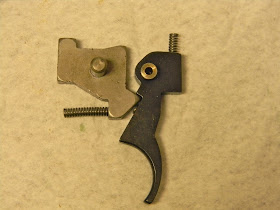
Pushed out the forward pivot pin and pulled the sear out.
Counterbore for the spring.
Removed the trigger return spring. It's exactly the same spring used on the sear.
To remove the trigger, the safety lever must be removed first. A very small set of external snap ring pliers is required.
Snap ring removed, and the safety's pivot and lever are pulled out. The sheet metal safety has small indentations for the detent ball. The ball is visible in the center of the trigger pivot pin.
Trigger pivot pin is hollow to house a small spring and ball bearing.
Like so.
Trigger/sear orientation--cocked. Note the overlap on surfaces. These are the locations to polish and lube to smooth the pull.
Trigger pulled, microseconds before the rifle fires.

Sear in fired position. Aside from polishing contact surfaces, I also cut a couple coils off the trigger return spring.
I fall into the "cross hatched" category for compression tubes. A quick pass with a Brush Research Flex-Hone finished the inside of the tube beautifully. Inexpensive at about $20.
Thin coat of moly on the piston and sides of the seal.
Mainspring got a coat of a viscous red synthetic grease. Added a rotation washer to the base of the spring guide and reassembled the compression tube. No pics, it was simply a reversal of the steps here.
While the bolt was still on the bench, it seemed like a good time to clean the barrel with J-B Non-Embedding Bore Cleaner.
Thin coat of silicone grease on the bolt o-ring...

and the transfer port o-ring.
Made sure the air passage in the bolt lined up when the handle is in the closed position.
Don't forget the setscrew to lock the handle in place.
The entire upper unit needs to be assembled before attaching the compression tube.

Dropped the action back into the stock, fired off about 40 shots then set up the chronograph. With a .20 cal H&N wadcutter, the Sterling was doing a smooth and consistent 570 fps. Great. I was hoping for at least another hundred fps. Dejectedly, I removed the compression tube again and pulled the mainspring and piston. Removed all the tacky red grease and burnished the spring with copper anti-seize. Next, I sized the piston seal down a few more thousandths for a looser fit in the compression tube. Reassembled and sent more shots downrange to settle things in. Across the chrony, the rifle was again still shooting that same 570 fps. Some of the old reference material gave specs for the .20 cal as 640 fps, so 570 seems way too slow. But, looking around, I can't find any real world .20 cal Sterling numbers to compare against.
There is perhaps still some efficiency to be gained by revisiting the transfer port and sleeving it to decrease volume and dead space. Possibly a tighter fitting o-ring on the bolt, or a different piston seal, too.
I'm not a velocity chaser, but find this is a bit too slow given the sheer size of the rifle. Maybe that's why it didn't fare well in the marketplace.
I think I'll pull the modified piston and install the original, unaltered piston from the .22 cal rifle just to get some numbers from a box stock component. Most likely, the only real gains will come from trying some different mainsprings.
We'll see what pans out.


















Nice rebuild! This is a fantastic blog. Maybe the steel washer you epoxied into the compression tube is hindering the airflow?
ReplyDelete